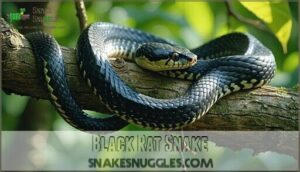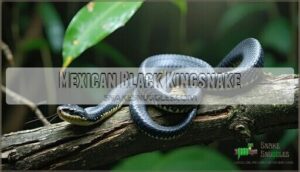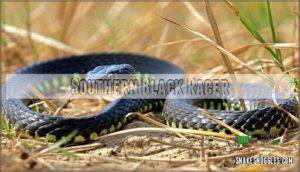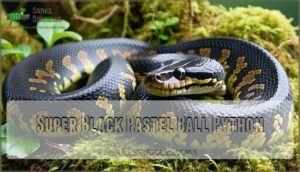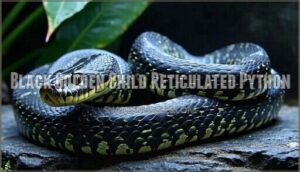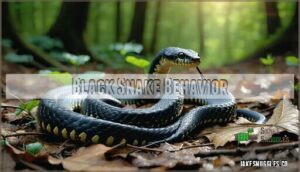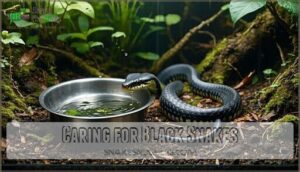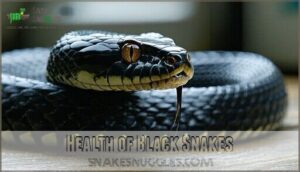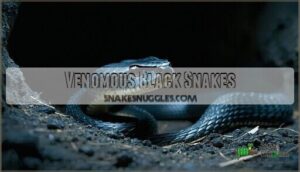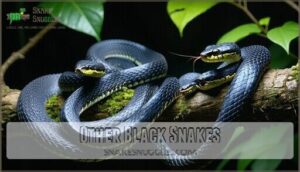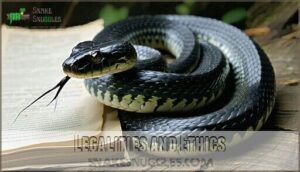This site is supported by our readers. We may earn a commission, at no cost to you, if you purchase through links.
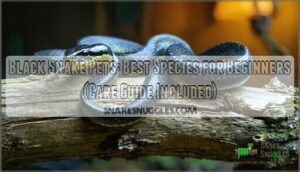
Species like the Mexican Black Kingsnake and Black Rat Snake make excellent beginner choices due to their calm temperaments and straightforward housing needs.
These sleek serpents typically require a 40-gallon tank with proper heating, humidity around 50-60%, and weekly feeding schedules.
Black snake pets rarely bite when handled correctly and adapt well to captive environments, with popular morphs including Super Black Pastel Ball Pythons and various black kingsnake varieties.
However, distinguishing between harmless species and dangerous lookalikes requires careful identification skills and local regulation knowledge.
Table Of Contents
- Key Takeaways
- Black Snake Pets
- Popular Black Snakes
- Black Snake Morphs
- Housing Black Snakes
- Black Snake Behavior
- Caring for Black Snakes
- Health of Black Snakes
- Venomous Black Snakes
- Other Black Snakes
- Legalities and Ethics
- Frequently Asked Questions (FAQs)
- Do black snakes make good pets?
- Can you own a black snake?
- How aggressive are black snakes?
- Are black king snakes good pets?
- Can you have a black snake as a pet?
- Are black house snakes good pets?
- What kind of snake is black?
- Can a black snake hurt you?
- What is the ideal tank decoration for black snakes?
- Can black snake species be housed together safely?
- Conclusion
Key Takeaways
- You’ll find that species like Mexican Black Kingsnakes and Black Rat Snakes make excellent beginner pets due to their docile temperaments and straightforward care requirements, typically needing just a 40-gallon tank with proper heating and 50-60% humidity.
- You can expect these snakes to live 15-20 years with weekly feeding schedules of frozen-thawed rodents, making them low-maintenance companions that rarely bite when handled correctly.
- You must distinguish between harmless pet species and dangerous venomous lookalikes like Black Mambas or Red-Bellied Black Snakes, which aren’t suitable for beginners and require expert-level experience.
- You’ll need to check local regulations before purchasing since permit requirements vary by state, with some areas banning certain species entirely, and you should always choose captive-bred specimens over wild-caught ones for ethical reasons.
Black Snake Pets
Black snake pets offer you a fascinating glimpse into reptilian mastery.
These sleek companions shatter black snake myths about aggression—most species are docile and beginner-friendly.
Wild black snakes have inspired legends across cultures, but captive-bred specimens make excellent starter pets.
Black snake evolution created diverse black snake species with unique temperaments and care needs.
Black snake conservation efforts protect wild populations while ethical breeding provides healthy pets.
Understanding black snake origins helps you appreciate these ancient predators.
With proper black snake care, you’ll discover why enthusiasts treasure these mysterious serpents.
Black snake morphs and competitive black snake prices reflect their growing popularity.
The strikingly black scales show iridescent hues.
Popular Black Snakes
You’ll find several black snake species that make excellent pets for beginners, each with unique traits that suit different experience levels.
The Black Rat Snake, Mexican Black Kingsnake, and Southern Black Racer stand out as the most popular choices because they’re docile, hardy, and relatively easy to care for in captivity, making them a great option for those looking for excellent pets.
Black Rat Snake
Among black snake pets, the Black Rat Snake (Pantherophis Obsoletus) stands out for its beginner suitability.
Black Rat Snakes deliver exceptional value for new reptile owners seeking their first serpentine companion.
This black snake species offers exceptional value for new reptile owners:
- Docile nature makes handling calmness achievable with regular interaction
- Adult size reaches 3-5 feet, perfect for home enclosures
- Captive lifespan extends 15-20 years with proper black snake care
- Low maintenance requirements suit first-time snake keepers perfectly
Mexican Black Kingsnake
Mexican Black Kingsnakes (Lampropeltis getula nigrita) captivate reptile enthusiasts with their striking ebony appearance and manageable three-foot size.
These black snake pets showcase calm temperaments through quality captive breeding programs.
Their straightforward dietary needs include appropriately-sized rodents, while activity enrichment prevents boredom in their modest enclosures.
Temperament variations remain minimal, making them excellent intermediate choices for dedicated snake care enthusiasts.
Southern Black Racer
Speed demons of the snake world, southern black racers aren’t ideal beginner pets despite their striking appearance.
These lightning-fast serpents reach 3-5 feet and prefer wild habitats over captivity.
Their nervous temperament and aggressive feeding response make snake handling challenging.
While their rodent-controlling abilities benefit ecosystems, experienced keepers should consider calmer species for successful snake care.
These snakes are also found in dryland locations, but prefer wild habitats.
Black Snake Morphs
You’ll find black snake morphs offer stunning variations that make these reptiles even more appealing as pets.
These genetic variations create different patterns and shades while keeping the same care requirements you’re already familiar with.
Super Black Pastel Ball Python
When you’re hunting for the ultimate super black pastel ball python, you’re targeting one of the most coveted snake morphs available.
These stunning specimens showcase rich dark brown coloration with distinctive tan markings that’ll make your collection shine.
Here’s what makes them special:
- Pastel genetics create the signature co-dominant mutation
- Super black results from breeding two pastel parents together
- Breeding combos produce consistent visual identification markers
- Morph variations display lighter juveniles that darken with age
- Visual identification includes solid head tops and pointed snouts
This snake species demands serious investment but rewards dedicated keepers.
First produced in the US, this morph has a unique co-dominant mutation.
Black Golden Child Reticulated Python
The Black Golden Child Reticulated Python showcases stunning genetics that create pure black scales with brilliant blue iridescence.
This morph results from breeding Golden Child genes into Calico genetics, producing hyperactive melanin. You’ll need massive enclosures since these giants reach 16+ feet.
| Aspect | Requirement | Notes |
|---|---|---|
| Enclosure Size | 8x4x4 feet minimum | Adult pythons need room |
| Temperature | 78-88°F gradient | Basking spot essential |
| Humidity | 50-60% | Monitor carefully |
| Feeding | Large rats/rabbits | Every 2-3 weeks |
| Temperament | Generally calm | Handle with confidence |
Housing Black Snakes
You’ll need to set up the right home for your black snake before bringing it to your new family.
Creating proper housing means choosing the correct enclosure size, maintaining proper temperatures, and providing the right humidity levels for your snake’s health and comfort.
Enclosure Size
Your black snake’s comfort depends on proper space requirements that match their natural behaviors.
Most species need enclosures measuring at least three times their snake length, with adequate vertical space for climbing species and substrate depth for burrowing needs.
Here’s what your snake enclosure size should include:
- Length: Minimum 3x your snake’s body length for spacious cage movement
- Width: At least half the snake size for comfortable turning radius
- Height: 12-18 inches minimum, more for arboreal species requiring vertical space
Add enrichment items like branches and hiding spots.
A hatchling bull snake, for example, can start in a 20-gallon tank.
Heating and Lighting
Temperature control gives you complete command over your snake’s comfort.
Create a heat gradient with a basking spot reaching 88-92°F and a cool side at 78-82°F.
Night temperatures can drop to 75°F.
Skip UVB lighting – most black snakes don’t need it.
Consider options for their reptile basking spot to guarantee proper thermoregulation.
Use thermostat control to maintain consistent snake enclosure temperature and prevent dangerous overheating that kills snakes.
Humidity and Substrate
Once your heating setup is dialed in, focus on creating the perfect foundation for your black snake enclosure. Getting substrate types and humidity levels right prevents shedding issues and keeps your snake comfortable.
Here’s what you need:
- Maintain snake enclosure humidity between 35-60% using a reliable hygrometer
- Choose snake substrate like aspen shavings or cypress mulch that supports burrowing needs
- Provide a large water bowl to boost humidity during shedding and prevent mold prevention issues.
Accurate readings require a reliable enclosure hygrometer. This helps in maintaining the right humidity levels and ensures your snake’s environment is comfortable.
Black Snake Behavior
Understanding your black snake’s behavior helps you create a better environment and build trust with your pet.
Most black snake species are naturally calm and docile, but they’ll show defensive behaviors like hissing or tail rattling when they feel threatened, which can be a sign to improve their environment to reduce defensive behaviors.
Temperament
Choosing the right black snake temperament means understanding their naturally calm disposition.
Most species show excellent docility factors and minimal aggression levels when properly socialized.
Your snake’s captive behavior will reflect consistent, gentle handling ease over time.
Each snake personality varies slightly, but black snakes generally demonstrate remarkable snake docility, making them ideal companions for patient keepers seeking rewarding snake handling experiences.
Defensive Behaviors
Snake defense mechanisms kick in when your pet feels cornered or stressed.
Understanding these behaviors helps you recognize when to back off and give your snake space.
- Hissing – Sharp exhales warn you to maintain distance
- Tail rattle – Vibrating against substrate mimics dangerous rattlesnakes
- Musk release – Foul-smelling secretions deter predators
- Feigning death – Some species play dead when extremely threatened
Handling Tips
Proper black snake handling starts with reading your snake’s mood. You’ll master snake safety by recognizing signals before each interaction.
- Safe Approach: Move slowly and let your snake see you coming
- Reducing Stress: Handle during evening hours when they’re naturally active
- Bite Prevention: Support their body weight with both hands underneath
- Handling Frequency: Limit sessions to 10-15 minutes every few days
- Recognizing Signals: Watch for defensive posturing or rapid tongue flicking
Caring for Black Snakes
You’ll find that caring for black snakes requires attention to three main areas: proper feeding schedules, fresh water access, and regular cage cleaning.
Most black snake species thrive when you feed them appropriately sized prey every 7-14 days and maintain clean water bowls with spot-cleaning between full substrate changes.
Feeding
Your black snake’s feeding schedule depends on prey size and species.
Adult snakes eat weekly, while juveniles need food every 5-7 days.
Frozen-thawed rodents prevent injuries and disease transmission.
Live feeding isn’t recommended for safety reasons.
Dietary variety keeps your snake healthy and engaged.
Frozen prey is ideal for snake nutrition.
| Snake Age | Feeding Frequency |
|---|---|
| Juvenile | Every 5-7 days |
| Adult | Weekly |
| Senior | Every 10-14 days |
Water Requirements
Your snake’s water bowl serves multiple purposes beyond simple drinking.
Fill it with dechlorinated water that’s deep enough for soaking during shedding cycles. This hydration method helps loosen old skin naturally.
Monitor humidity levels between 50-60% for most species. Light misting twice weekly maintains proper moisture without oversaturating your snake enclosure.
Clear eyes indicate excellent snake care and adequate hydration.
Cage Maintenance
Consistency beats perfection when maintaining your snake enclosure.
You’ll master this routine quickly with these essential steps:
- Substrate Cleaning: Remove soiled bedding weekly and replace completely monthly
- Water Sanitation: Change water every 5-7 days, scrubing bowls thoroughly
- Enclosure Disinfection: Wipe surfaces with reptile-safe cleaner monthly
- Mold Prevention: Monitor humidity levels and ventilation daily
Selecting the right snake bedding options is vital for their health.
Health of Black Snakes
You’ll need to watch for several health problems that commonly affect black snakes, including respiratory infections, mites, and shedding issues.
Catching these problems early makes treatment much easier, so you should check your snake regularly for changes in behavior, appetite, or appearance, which can be indicative of a health problem.
Common Health Issues
Looking after your black snake’s health means staying alert for several issues that can sneak up on you. Respiratory infections top the list, followed by scale rot, parasites, and mouth rot. Obesity also threatens many pet snakes due to overfeeding.
| Health Issue | Key Symptoms |
|---|---|
| Respiratory Infections | Wheezing, mouth breathing, lethargy |
| Scale Rot | Discolored scales, soft belly spots |
| Parasites | Weight loss, poor appetite, sluggish behavior |
| Mouth Rot | Swollen gums, cheesy discharge, reluctance to eat |
| Obesity | Difficulty moving, fat rolls, labored breathing |
These snake diseases require quick veterinary attention to prevent serious complications.
Signs of Illness
Your pet’s health signals come through clear warning signs.
Respiratory distress shows as open-mouth breathing or wheezing. Lethargy and anorexia indicate serious problems.
Watch for these red flags:
- Scale issues – discoloration, retained shed, or unusual texture
- Abnormal shedding – pieces stuck or incomplete molts
- Behavioral changes – hiding excessively or aggressive responses
Quick action saves lives when snake diseases strike.
Quarantine New Snakes
Always quarantine new Pet Snakes for 30-60 days before introducing them to your collection.
Set up a separate Isolation setup with basic heating and hiding spots for Snake Health monitoring.
Watch for respiratory issues, mites, or unusual behavior during Snake Quarantine. This Preventing spread approach protects existing snakes while allowing Stress reduction for newcomers.
Snake Beginners should never skip this Snake Care step.
Venomous Black Snakes
You’ll encounter some black snakes that pack dangerous venom, like the notorious Black Mamba and the Red-Bellied Black Snake from Australia.
These species aren’t pets for beginners—they’re strictly for experienced professionals who understand the serious risks involved.
Black Mamba
While black mambas aren’t actually black—they’re olive or brownish—these 14-foot African giants get their name from their blue-black mouths.
You can’t keep this venomous snake species as a pet due to their lethal mamba venom and aggressive mamba behavior.
Mamba antivenom exists, but snake bites from these fast serpents often prove fatal without immediate treatment.
Red-Bellied Black Snake
Australia’s RedBellied Blacksnake (Pseudechis porphyriacus) isn’t your typical pet snake choice. This venomous species requires experienced handlers who understand its venom potency and Australian habitat needs.
Unlike beginner-friendly snake species, handling precautions are critical. Their dietary needs include rodents, while enclosure specifics demand spacious housing with proper heating. Snake temperament varies, making this challenging territory.
- Venom potency makes bites painful but rarely fatal to humans
- Requires large enclosures (4+ feet long) with temperatures 70-90°F
- Feeds on thawed rodents, chicken, and specialized diets
- Lives 12-15 years with expert husbandry and handling precautions
Other Black Snakes
You’ll find several other black snake species that make excellent pets for beginners, including the low-maintenance Black African House Snake and the impressive Eastern Indigo Snake.
These species offer unique characteristics and care requirements that might suit your specific preferences and experience level better than the more common options, providing a better alternative.
Black African House Snake
Originating from sub-Saharan Africa, the Black African House Snake (Boaedon fuliginosus) makes an excellent beginner pet snake.
These docile serpents display calm snake temperament and simple housing needs—just a 40-gallon tank with moderate humidity.
Their snake diet consists of frozen-thawed rodents every 7-10 days, and with good breeding potential and stable conservation status, they’re ideal starter pet snakes.
Eastern Indigo Snake
You’ll find the eastern indigo snake stands as America’s longest native serpent, reaching nearly 9 feet.
This magnificent black snake requires expert-level care due to its size and legal protection status.
Captive breeding programs support indigo conservation efforts while providing specimens for experienced keepers who can meet their extensive habitat needs.
Key considerations for eastern indigo snakes:
- Snake lifespan reaches 8-12 years with proper husbandry and care
- Temperament specifics include docile nature despite their intimidating size
- Snake diet consists of fish, amphibians, reptiles, birds, and small mammals
- These pet snakes need massive enclosures (minimum 8x4x4 feet) for adult specimens
- Snake species classification as threatened makes ownership heavily regulated nationwide
Black-Headed Python
The black-headed python commands attention with its striking appearance and unique traits.
This Australian native combines a jet-black head with vibrant golden-yellow body patterns, creating a stunning contrast that captivates snake enthusiasts.
Key characteristics include:
- Captive Care: Requires experienced handlers due to specific temperature and humidity needs
- Temperament Traits: Generally docile but can be defensive when stressed or threatened
- Enclosure Needs: Large terrariums with proper ventilation and climbing opportunities essential
- Diet Specifics: Feeds on birds, small mammals, and reptiles in wild; accepts frozen-thawed prey
- Breeding Behavior: Notoriously difficult to reproduce, making specimens expensive and rare
Legalities and Ethics
Snake ownership comes with serious legal responsibilities. Permit requirements vary by state, with some banning constrictors or venomous species entirely. Snake legislation often targets invasive species that threaten local ecosystems.
Know your local laws before bringing home that dream snake—compliance protects both you and wild populations.
Before purchasing, check your area’s snake commerce regulations.
Ethical breeding practices matter too. Choose captive-bred snakes over wild capture specimens to support snake conservation efforts. Responsible dealers won’t sell animals with questionable conservation status.
The snake trade thrives when buyers make informed choices.
Your commitment to legal compliance and ethical sourcing protects both wild populations and your right to keep these incredible animals as companions.
Frequently Asked Questions (FAQs)
Do black snakes make good pets?
Yes, you’ll find black snakes can make excellent pets! Species like black rat snakes and African house snakes are docile, low-maintenance, and perfect for beginners with proper housing and care.
Can you own a black snake?
Looking to break free from traditional pets?
You can absolutely own a black snake as your companion.
Many species like black rat snakes and Mexican black kingsnakes make excellent, legal pets for dedicated owners.
How aggressive are black snakes?
Black snakes aren’t naturally aggressive creatures.
Most species you’d keep as pets are quite docile, though they’ll defend themselves when threatened.
You’ll find captive-bred specimens are typically calmer than wild-caught ones.
Are black king snakes good pets?
Who needs a pet that’s actually friendly, right?
Mexican Black Kingsnakes make excellent beginner pets.
They’re docile, grow only three feet long, live 15-20 years, and require simple care with proper temperatures.
Can you have a black snake as a pet?
Several black snake species make excellent pets, including black rat snakes and Mexican black kingsnakes.
You’ll find them docile, low-maintenance, and perfect for beginners.
They’re non-venomous with 15-20 year lifespans when properly cared for.
Are black house snakes good pets?
African house snakes make excellent beginner pets.
You’ll love their docile nature, easy care requirements, and 15-20 year lifespan.
They’re low-maintenance, rarely bite, and adapt well to captivity with proper temperature control, making them a great choice due to their low-maintenance care.
What kind of snake is black?
You’ll find many snake species with black coloration, including rat snakes, kingsnakes, and house snakes. These reptiles range from docile pet-friendly varieties to venomous species requiring expert handling and care.
Can a black snake hurt you?
Most black snakes won’t harm you since they’re non-venomous constrictors.
However, some species like Australia’s red-bellied blacksnake pack venomous bites.
You’ll want to identify the species before handling any black snake safely.
What is the ideal tank decoration for black snakes?
You’ll want sturdy hiding spots, climbing branches, water bowls, and substrate for burrowing.
Add cork bark, artificial plants, and smooth rocks. These decorations mimic their natural habitat while providing security and enrichment.
These elements work together to create a comfortable and stimulating environment for the animals.
Can black snake species be housed together safely?
Housing different black snake species together isn’t recommended.
Most species are solitary and territorial, leading to stress, aggression, or cannibalism.
California Kingsnakes particularly eat other snakes.
Keep them separated for their safety.
Conclusion
Choosing black snake pets transforms novice reptile enthusiasts into confident keepers practically overnight.
You’ve learned that species like Mexican Black Kingsnakes and Black Rat Snakes offer ideal starter experiences with their docile temperaments and straightforward care requirements.
Remember to verify local regulations before purchasing, maintain proper enclosure conditions, and always distinguish between harmless species and dangerous lookalikes.
With weekly feeding schedules and basic habitat maintenance, you’ll enjoy years of rewarding companionship with these magnificent serpents.

